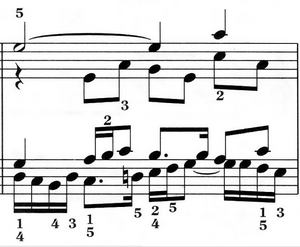Part (music) facts for kids

In music, a part is a specific line of music. It is played by one musician or a group of musicians. For singers, it's the line sung by one or more singers. This is the main way we use the word "part" when talking about music compositions.
When many instruments play the same notes together, they are playing the same part. For example, all the first violins in an orchestra play the same part. The second violins play a different part, and the violas play another.
In a string quartet, there are four instruments: two violins, a viola, and a cello. Each of these four instruments plays its own unique part.
When a group of singers all sing the main tune together, they are singing in unison. But if they split up, like into soprano, alto, tenor, and bass voices, they are singing in four parts. The sopranos might sing the main tune, while the altos, tenors, and basses add harmony underneath. This is called "4-part harmony." If each of the four parts has its own melody, it's called polyphonic music. Polyphonic music always has several different parts playing at once.
Music for piano or organ can also be written with a set number of parts. For example, a 5-part fugue for piano has five distinct musical lines. Even though one person plays it, it's like five different instruments are playing. Each part has its own line of music, even if it rests sometimes.
Another word for a musical part is voice. In many other European languages, the word for a musical part is the same as the word for voice. For example, in German it's Stimme, and in French it's voix.
Generally, the more parts a piece of music has, the harder it is to write. All the parts must fit together to sound good. The 16th century composer Thomas Tallis wrote a motet called Spem in alium. This amazing piece has 40 parts! A choir of at least 40 people is needed to sing it, and each person sings something different from everyone else.
Orchestral Parts: Printed Music
The word "part" can also mean the actual printed music a musician uses. For example, the oboe part will only show the notes the oboe player needs to play. It doesn't show what other instruments are playing.
In contrast, the conductor of an orchestra uses a musical score. This score shows all the instrumental parts written one below the other. This way, the conductor can see everything that's happening in the music at once.
"Part" Meaning "Section"
Sometimes, "part" is used in its everyday meaning, which is a "section" or a piece of something. For example, you might say, "the first part of the movement is played only by the woodwind instruments." This means the woodwind section plays at the beginning.
Large musical works, like an oratorio, are sometimes divided into two or three "Parts." In an opera, these main sections are usually called "Acts."
Images for kids
See also
 In Spanish: Particella para niños
In Spanish: Particella para niños

